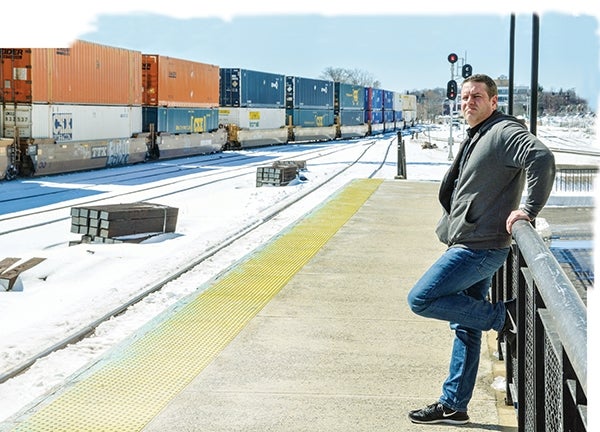Treating addiction
 Edd Cote
Jake Nichols, a recovering addict, advises insurers, doctors and others on medication-assisted treatment.
Edd Cote
Jake Nichols, a recovering addict, advises insurers, doctors and others on medication-assisted treatment.
At 18, Jake Nichols had never tried anything harder than alcohol or marijuana. It wasn’t until he got to college and started taking Adderall as a study aid that the floodgates opened.
As a pharmacy student, he had access to pretty much every drug on the market. It was a slippery slope, and eventually, Nichols became addicted to Adderall and Vicodin.
“As a pharmacist, you’re like a kid in the candy store,” he said. “You have access to pretty much everything.”
He struggled with his disease for 15 years, but has now been clean since 2010. The path to recovery began with suboxone treatment and a five-year stint in the Massachusetts Professional Recovery System, a treatment program for medical professionals and students struggling with addiction. Today, he lives in Natick and works for Orexo, a pharmaceutical company based in New Jersey, where he advises insurers, physician groups, and others about medication-assisted treatment.
“I was fascinated by the multi-faceted nature of the disease, and how complicated it is. I met a lot of people who I wouldn’t hesitate to call saints -- they do this because they care about people, they don’t judge,” he said. “They just want to help people. I was lucky to be able to find the opportunity to work in the field.”
The Massachusetts Department of Public Health estimates that nearly 2,000 people died from unintentional opioid overdoses in 2016, a 16 percent increase over the year before and a 184 percent increase in five years. Although stigmas surrounding medications like methadone and suboxone are prevalent, health care providers see medication-assisted treatment, when used properly, as one of the most useful tools in helping reduce those numbers.
“I’ll be clear: [These medicines] can be life-saving,” said Dr. Richard Listerud, medical director of recovery services at Harrington HealthCare System in Southbridge. “They are not cures, but in the context of an extended treatment plan, involving counseling, and continued adherence to medication management, these medications save lives.”
Different meds
The most common opioid treatment medications are methadone, suboxone, and naltrexone, along with vivitrol, the injectable version of naltrexone, according to Kurt Isaacson, president and CEO of Spectrum Health Systems, the Worcester-based treatment nonprofit. Methadone has to be administered daily, suboxone is usually a 30-day supply, and a vivitrol shot, administered by a physician, is good for up to a month as well.
For each patient that comes in, Spectrum develops a treatment plan based on how long they have been using, whether or not they’ve tried treatment before, what kind of support they have at home, and other factors, he said. Which medication patients use varies from person to person, said Isaacson.
“It would essentially be the difference between treating a headache with ibuprofen or with a different medicine,” he said.
Listerud agreed that the best treatment plan involves not only these medications, but also ancillary services, like group therapy and other counseling services. Methadone is fairly intensive, and requires people to go in every day for medication. Group therapy has also been shown to make naltrexone and vivitrol much more effective, he said. But they’re not a cure for the disease by any means.
“They are treatments which can help supplement an individual’s attempts to battle their addiction,” said Listerud.
The medicines mute withdrawal symptoms, so the individual can then focus on the behavioral aspects contributing to his or her disease, said Nichols.
“For a more extended period of time, it will reduce and eliminate cravings, which are really what leads to relapse,” he said.
While dealers do sell methadone and suboxone on the streets with the goal of eventually getting people back on more profitable heroin, the narrative of “trading one addiction [opiates] for another [medication-assisted treatment]” is false, doctors said.
“I don’t think it’s a direct parallel, but no one would say you shouldn’t as a diabetic use insulin to control diabetes,” said Isaacson. “When you say ‘I’m going to use medication-assisted treatment to control addiction,’ there are some people in the community — and it’s not the consensus by any means — that have a concern about that. Obviously, we don’t.”
Recovery process
For some families, medication-assisted treatment has been nothing short of a godsend. For Nick and Peggy, a couple who asked that their last name be omitted, this was the case. When their son was first trying to get clean with suboxone, he would sell it on the street and trade it for heroin. At that point, he wasn’t ready to fully commit to his recovery, according to his parents.
It wasn’t until he got out of a detox program and into a hotel away from his friends, family and community that he was finally ready to try medication-assisted treatment and take it seriously. With the help of suboxone and counseling, he has been clean for two years. He still takes suboxone, according to his parents.
“I don’t want to say it’s been a miracle for him, but it’s been close to it,” said Nick, who asked that his son’s name be omitted. “When they’re ready, when they’re getting counseling, and using suboxone in the correct way, it works.”
Despite the good it does for people, the stigmas are still very prevalent, said Nichols, and even though medications can be effective in helping people in their recovery, withdrawals can still be painful.
“There’s a pretty good period at the beginning which is really, really tough. I don’t care what medication you take, you’re going to struggle during that initial period of three to six months,” Nichols said.












0 Comments